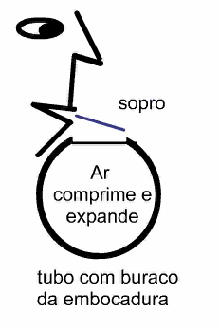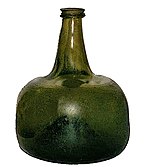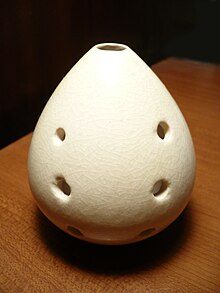Vessel flute
Avessel fluteis a type offlutewith a body which acts as aHelmholtz resonator.The body is vessel-shaped, not tube- or cone-shaped; that is, the far end is closed.
Most flutes havecylindricalorconical bore(examples:concert flute,shawm). Vessel flutes have more spherical hollow bodies.
The air in the body of a vessel fluteresonates as one,with air moving alternately in and out of the vessel, and the pressure inside the vessel increasing and decreasing. This is unlike theresonance of a tube or cone of air,where air moves back and forth along the tube, with pressure increasing in part of the tube while it decreases in another.
Blowing across the opening of empty bottle produces a basic edge-blown vessel flute. Multi-note vessel flutes include theocarina.[1]
A Helmholtz resonator is unusually selective in amplifying only one frequency. Most resonators also amplify moreovertones.[2]As a result, vessel flutes have a distinctive overtoneless sound.
Types
[edit]Fipple vessel flutes
[edit]These flutes have afippleto direct the air at an edge.
Areferee's whistleis technically a fipple vessel flute, although it only plays one note.
Edge-blown vessel flutes
[edit]
These flutes areedge-blown.They have no fipple and rely on the player's mouth to direct the air at an edge.
- Xun
- Borrindo
- Hand flute
- Kōauau ponga ihu (aMāorigourd vessel flute played with the nose)[citation needed]
- Ipu ho kio kio (a similar instrument from Hawai'i)[citation needed]
- Blown bottle
Other
[edit]Theshepherd's whistleis an unusual vessel flute; the fipple consists of two consecutive holes, and the player's mouth acts as a tunablevessel resonator.Anose whistlealso uses the mouth as a resonating cavity, and can therefore vary its pitch.
Acoustics
[edit]Sound production
[edit]
Sound is generated by oscillations in an airstream passing an edge, just as inother flutes.The airstream alternates quickly between the inner and outer side of the edge.
The opening at which this occurs is called thevoicing.[3]
Some vessel flutes have afippleto direct the air onto the labium edge, like arecorder.Others rely on the player's lips to direct the air against the edge, like aconcert flute.Fippleless flutes are callededge-blown flutes.
The pitch of a vessel flute is affected by how hard the player blows. Breath force can change the pitch by several semitones,[4][5]though too much or too little air will also harm the tone,[6]so the usable range of tones is much smaller. The optimal breath force depends on which pitch is being sounded (according to the instrument'sbreath curve).[7]This is why it is hard to learn to play a vessel flute in tune.
Vessel flutes generally have no tuning mechanism, partly because they rely on variations in breath pressure and partly because the volume of the chamber and the size of the voicing need to be matched to produce a good tone. A few have plungers that change the chamber volume.[7]
Fingering holes and fingers that are too close to the labium disrupt the oscillation of the airstream and hurt the tone.
Amplification
[edit]At first the sound is a broad-spectrum "noise" (i.e. "chiff" ), but those frequencies that match the resonant frequency of the resonating chamber are selectively amplified. The resonant frequency is the pitch of the note that is heard. Vessel flutes use the air in a vessel for amplification; the vessel acts as aHelmholtz resonator.
Other things being equal, vessel flutes are louder when they use more air,[6]and when they are being played at higher pressures.
Pitch and fingering
[edit]The resonant frequency of a vessel flute is given by this formula: (heavily simplified, seesimplifications)[8]
From this, one can see that smaller instruments are higher-pitched. It also means that, in theory, opening a specific hole on an instrument always raises the pitch by the same amount. It doesn't matter how many other holes are open; opening the hole always increases the total area of the open holes by the same amount.
A vessel flute with two fingering holes of the same size can sound three notes (both closed, one open, both open). An vessel flute with two fingering holes of different sizes can sound four notes (both closed, only the smaller hole open, only the bigger hole open, both open). The number of notes increases with the number of holes:
| Number of holes | 0 | 1 | 2 | 3 | 4 | 5 | 6 | 7 | 8 | 9 | 10 |
|---|---|---|---|---|---|---|---|---|---|---|---|
| Number of notes | 1 | 2 | 4 | 8 | 16 | 32 | 64 | 128 | 256 | 512 | 1024 |
| Powers of two | 20 | 21 | 22 | 23 | 24 | 25 | 26 | 27 | 28 | 29 | 210 |
In theory, if the smallest hole were just big enough to raise the pitch by asemitone,and each successive hole was twice as big as the last, then a vessel flute could play a scale of 1024 fully-chromaticnotes. Fingering would be equivalent to counting infinger binary.
In practice, the pitch of a vessel flute is also affected by how hard the player blows. If more holes are open, it is necessary to blow harder, which raises the pitch. The high notes tend to go sharp; the low notes, flat.[5]To compensate, fingering charts soon diverge from the plain binary progression.
The same pitch can be made with a variety of vessel shapes, as long as the cavity resonates as a Helmholtz resonator. This is why vessel flutes come in a variety of shapes. The chamber shape does, however, affect the acoustics and ergonomics; it is not entirely arbitrary.[9]
Overtones
[edit]Theresonatorin the ocarina can createovertones,but because of the common "egg" shape, these overtones are many octaves above the keynote scale.[2]In similar instruments with a narrow cone shape, like theGemshornorTonette,some partial overtones are available.Overblowingto get a range of higher pitched notes is possible on the ocarina, but not widely done, because the resulting notes are not "clean" enough.[citation needed]
Multiple resonant chambers
[edit]
Some ocarinas are double- or triple-chambered, often with the chambers tuned an octave or a tenth apart. This allows the player to play chords, but it also allows an increased range.[citation needed]
A chamber with a smaller range can be more tuned to better characteristics throughout its range; a chamber with a large range will, for basic physical reasons, have more borderline characteristics at the extremities of its range. Splitting a large range over multiple chambers makes for a smaller range per chamber. So for the same range, multichambers can have a better tone. The optimal air pressure can also be more consistent between notes (a flatter breath curve), making multichambers easier to play, especially for fast music with large jumps in pitch.[10]
Physics simplifications
[edit]Aless-simplified formula for the resonant frequency of a Helmholtz resonator is:[8]
Wherefis the resonant frequency,vis the speed of sound,Ais the total area of openings in the vessel, andVis the volume of air enclosed in the vessel.
The pitch of a Helmholtz resonator is also affected by how far the air has to go to get in or out of the resonator; in other words, the thickness of the material the holes are cut in.
Variations in the speed of sound
[edit]Thespeed of sound,assumed to be constant above, is in fact somewhat variable.
The speed of sound in air varies with temperature, meaning that a vessel flute's pitch will change in hot or cold air. However, varying the playing airspeed can change the pitch by several semitones.[4]Unfortunately, most of this range is not usable, only about third of a semitone / 30cents(for music with rapid or complex note transitions, the practical limit is only 5-10 cents).[5][7]This is enough to cancel the expected pitch effects of moderate temperature changes (±20-30Celsiusfor simple music, ±4-5 Celsius for complex music). The low notes can be made to sound good and in-tune at a variety of pressures, but the higher pitches are substantially less sensitive to changes in pressure. At low temperatures, the high notes may squeak before the player can blow hard enough to bring them in tune; at high temperatures, the high notes will require so little air that they sound too airy. Ocarina makers can give information on the temperature a specific ocarina was tuned for, the temperature which will give its designed tone.[5][7]
Air pressure variations do not affect pitch. The ratio of pressure to air density in anideal gasis constant. Air pressure and density changes therefore cancel, and have no effect on the speed of sound; air is nearly an ideal gas, so there is nearly no effect.
Humidity has a comparatively small effect on the speed of sound. Going from zero to 100% relative humidity should change the frequency by less than a two-degree-Celsius change in room temperature.[11]As the player's breath has ~100% relative humidity, the humidity can't vary that much anyway.
See also
[edit]References
[edit]- ^For a linguistic analysis of the possible origins of the wordocarina:
Perono Cacciafoco, Francesco (2019)."A Prehistoric 'Little Goose': a New Etymology for the Word ocarina".Analele Universităţii din Craiova.Ştiinţe Filologice. Lingvistică.41(1–2): 356–369.ISSN1224-5712. - ^abFundamentals of Musical Acoustics.Arthur H. Benadepp.473–476
- ^Hickman, Richard."An introduction to the ocarina's fingering system".pureocarinas.com.Pure Ocarinas.Retrieved8 March2021.
- ^abHickman, Robert."Playing the ocarina in tune - ocarina intonation".pureocarinas.com.Pure Ocarinas.
- ^abcdHickman, Robert."Playing the ocarina in tune - ocarina intonation - Pure Ocarinas".Pureocarinas.com.Retrieved21 November2018.
- ^abHickman, Robert."How air temperature affects an ocarina's pitch".pureocarinas.com.Pure Ocarinas.Retrieved8 March2021.
- ^abcdHickman, Robert."Playing ocarinas in tune in warm or cold environments".pureocarinas.com.Pure Ocarinas.Retrieved7 March2021.
- ^ab"Ocarina Physics".ocarinaforest.com. Archived fromthe originalon 2013-03-14.Retrieved2012-12-30.
- ^"Interview with Robert Hickman".The Ocarina Museum.Retrieved8 March2021.
- ^Hickman, Robert."Increasing ocarina range - adding holes vs adding chambers".pureocarinas.com.Pure Ocarinas.Retrieved8 March2021.
- ^Sengpiel, Eberhard."Calculation speed of sound in humid air and the air pressure humidity moist air water vapor density of water atmospheric pressure - sengpielaudio Sengpiel Berlin".Sengpielaudio.com.Retrieved21 November2018.
Further reading
[edit]- Liggins, David, and Christa Liggins. (2003).The Ocarina: A Pictorial History.Kettering: Ocarina Workshop.
- Perono Cacciafoco, Francesco. (2019). A Prehistoric 'Little Goose': A New Etymology for the Word 'Ocarina'.Annals of the University of Craiova: Series Philology, Linguistics,XLI, 1-2: 356-369,Paper.







